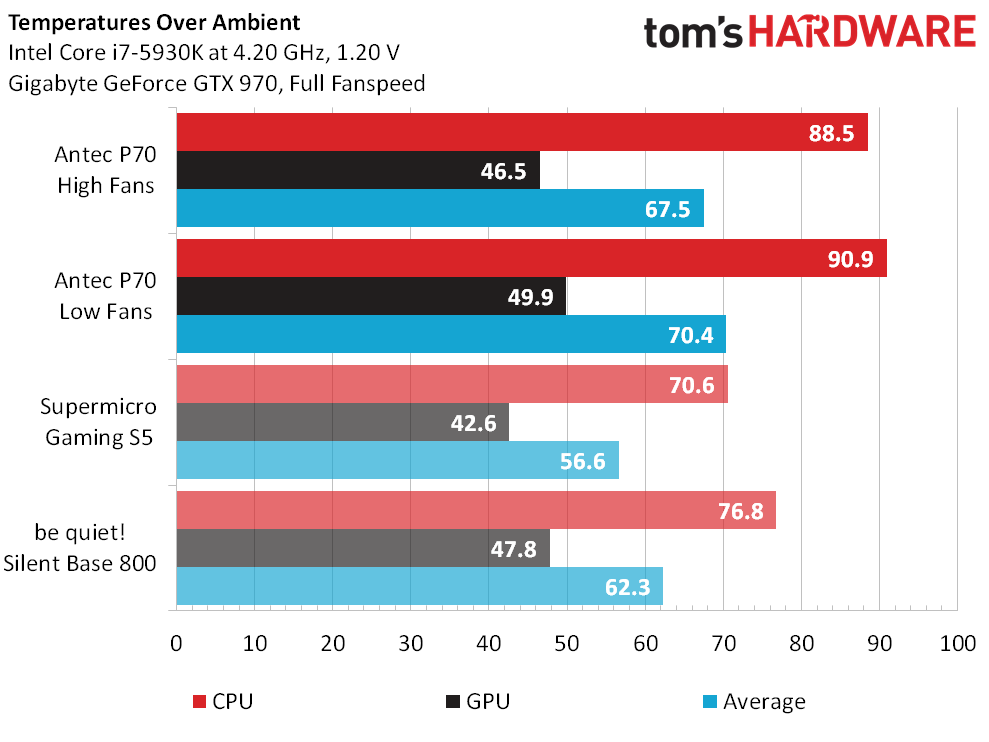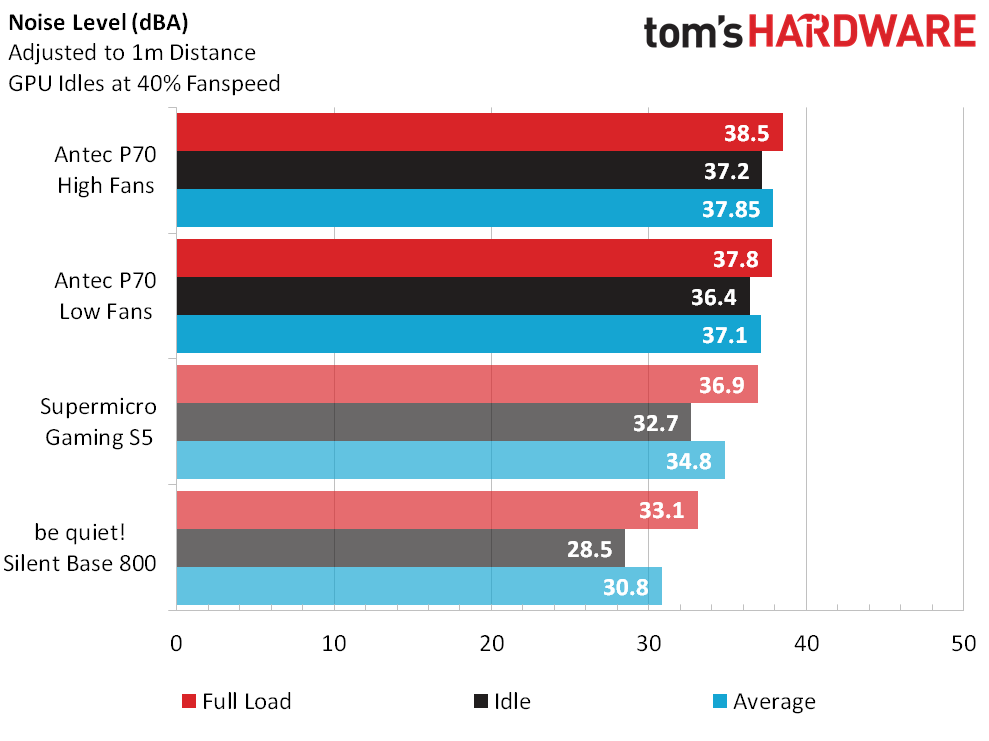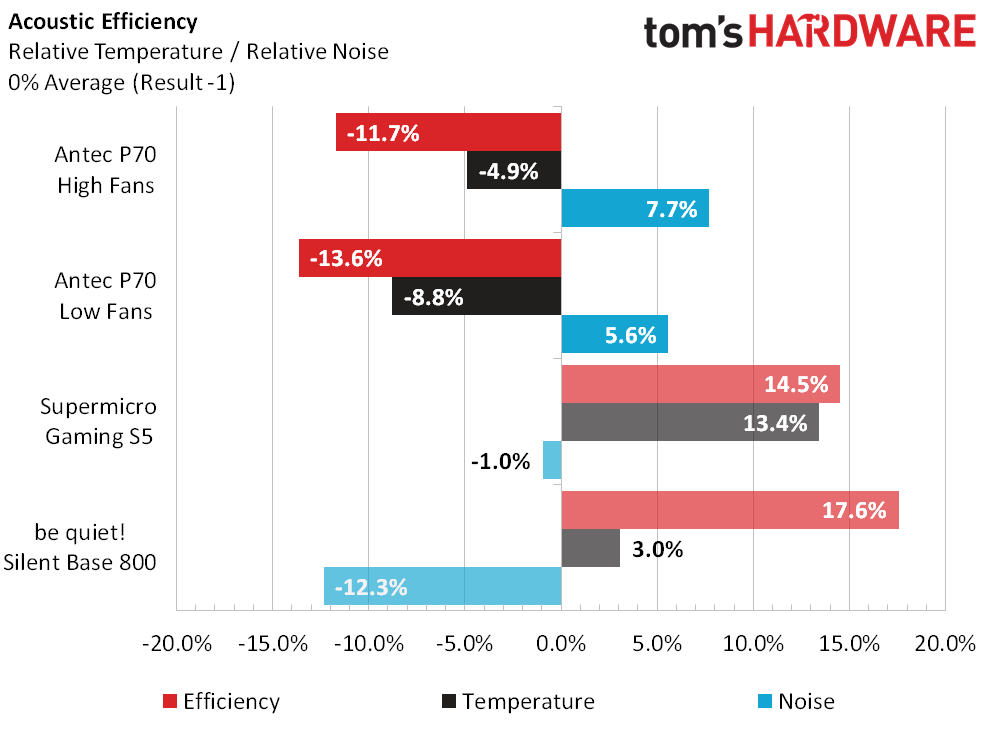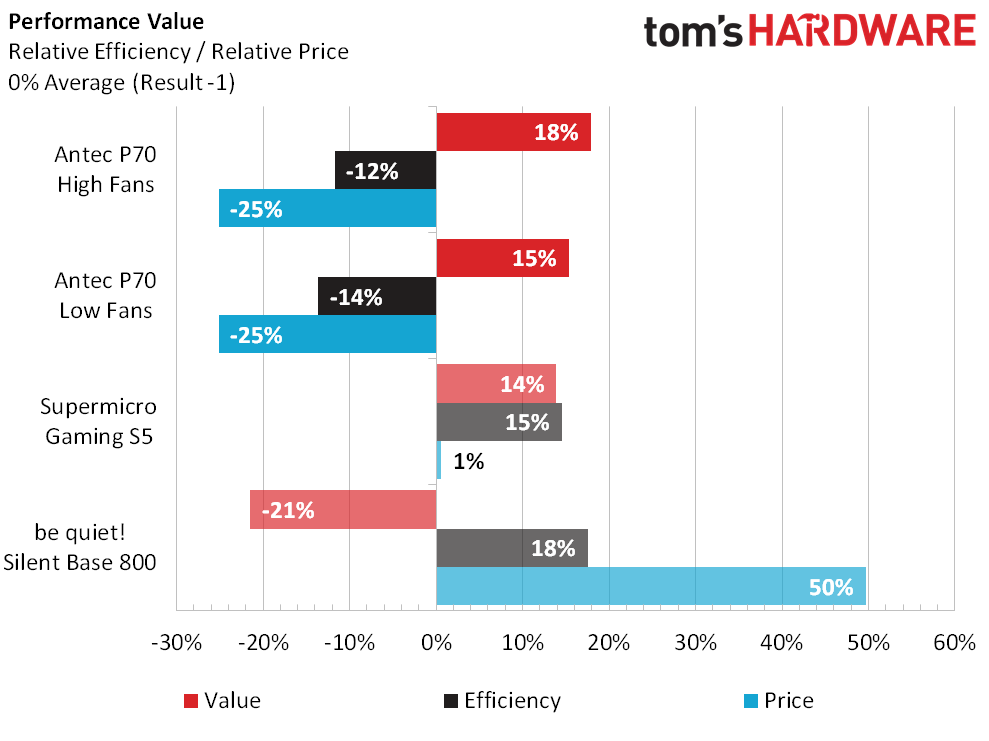Antec P70 ATX Mid-Tower Case Review
Antec’s latest low-cost chassis carries the company's gaming hardware-oriented “Performance” moniker, but can it really perform? We find out.
Why you can trust Tom's Hardware
Test Results And Analysis
Today’s test uses the same hardware and settings as the previous be quiet! and Supermicro case reviews, allowing us to produce comparable results without retesting previous samples.
Do those temperatures seem a little high? Generating test results on the P70 without encountering host processor thermal throttling was accomplished only after raising the CPU’s threshold (in UEFI) to 115 °C and lowering the room temperature to a chilly 15°. Though we might have been able to get the CPU temperature down by 10° by using a huge cooler, the P70 appears to be designed for lesser hardware. Perhaps a Core i5 at a similar clock rate and voltage?
Super-thin side panels do little to isolate internal component noises from the outside of the case. Even the Supermicro Gaming S5 with its vented side-panels is slightly quieter.
Hot and noisy are not good adjectives in a cooling-to-noise comparison, though the P70 has a lower price to help excuse its performance deficit. Cheap system builders don’t want canned heat, but cheaper processors usually have less heat to manage.
The point is seen in our charts, where even the combination of poor cooling and noise control isn’t enough to prevent a value win. We should probably recommend the P70 to someone as a result. But we still aren't quite sure who this case is built to attract. Even as the P70 occasionally dips below $60, we wonder whether we should do an exhaustive search for a higher-quality product at a similar price or drop an extra $20 on a true budget-oriented enthusiast chassis. Antec sells those too. Even its venerable Nine Hundred is available for less than $100. Given what we’ve seen here, we’d probably spend more on something better.
Get Tom's Hardware's best news and in-depth reviews, straight to your inbox.
-
SinxarKnights Hmm I just got rid of my 300 about a month ago. Is this really the 300's replacement? The 300 lacked any 2.5" bays but had great cooling with only the 2 included three speed fans. It seems they made the same mistake twice by sitting the motherboard too close to the top so it is practically impossible to mount a rad on the inside there.Reply
Considering it is a $70 case, surely there must be much better options than this for budget builders. -
JeanLuc Argh, what's wrong with the site?? All the alignment is out. I was reading through the price list and the case came up at $46.99 now it says $70.Reply -
SinxarKnights Reply15864394 said:^^ It's not a $70 case you can pick it up for $47.
It is 47 because it is on sale. It is a $70 case. -
Plyro109 I'm rather sad Antec still doesn't seem to want to make fan filters easy to access. That's why I replaced my 902, and why I've been steering people away from their cases for a while.Reply
To clean the filters on the 902, it required removing 20(!) screws, and this case requires the removal of the front panel, and thus, both the side panels also. At the least, it looks like the top and rear filters are a bit easier to access, which is a step forward.
Probably not a case I'll be recommending for others to use, even if it is inexpensive. -
InvalidError Reply
The 300-2 had one 2.5" spot at the bottom and another behind the motherboard tray.15864007 said:Hmm I just got rid of my 300 about a month ago. Is this really the 300's replacement? The 300 lacked any 2.5" bays
I own both a 300 and 300-2. My biggest pet peeve about them is having to unplug everything I may have plugged into front jacks and open the side panel to un-clip the front panel so I can remove it every time I want to clean the filters. Another problem with the 300s is that the filter sits so close to the front mesh that dust accumulates directly behind the front mesh' holes - there is not enough space for airflow to spread out evenly across the filter. I would probably need to clean the filter half as often if there was even only 1mm of extra clearance here.
Yet another filter-related pet peeve is the PSU filter: half the dust gets scraped off the filter and sucked right back in when the filter is removed for cleaning. IMO, the 300-2 would have been better off without it, letting the PSU draw from case air like it did in the original 300. -
jimmysmitty I think that Antec has been left behind in terms of case design. I do remember when I wanted a 900 but most of their cases are just now coming with features that others have had.Reply
I find it strange that this is lacking side fan mounts. Even the Corsair 200R has those and that is a $60 dollar case right now. -
InvalidError Reply
The 300-2 had side fan mounts on both panels. On my case though, both of them are taped shut to limit dust ingress. In an ocean of cases with goady side panels. There is no point in having windows or side vents when the case is wedged between a desk and a wall. The top fan is unplugged and the vent taped shut to prevent screws and whatever else I might have on my desk dropping into my PC through the top fan.15865011 said:I find it strange that this is lacking side fan mounts. Even the Corsair 200R has those and that is a $60 dollar case right now.
Sometimes, less is more. I would pay $10 more than I paid for my 300-2 for an otherwise identical case that had no side vents, no dedicated PSU filter/intake and no top vent for me to worry about but had direct access to intake filters. -
aldenf I'll assume, since it is not mentioned in the article, that the two top fans are configured for exhaust. Three exhaust and no intake fans seems completely inappropriate for hot hardware. Since the option is provided "out of the box", I'd like to see the top fans moved to the front as intakes and the plug/panel installed on top. This should show very different numbers in testing. I'm rather surprised it wasn't attempted initially by the builder/reviewer as it seems rather obvious.Reply
I'm not sure how many users would be trying to squeeze an extended MB into an inexpensive case. I don't see it as a con at all. Many enthusiasts look for more compact cases for ATX/m-ATX builds. If the P70 will often be on sale for <$50 and moving the two top fans to the front as intakes shows better all around performance as I expect, methinks the P70 could be a killer option for moderately priced gaming rigs/workstations.
I'll wait for a more thorough review of the product before making any final judgements...




